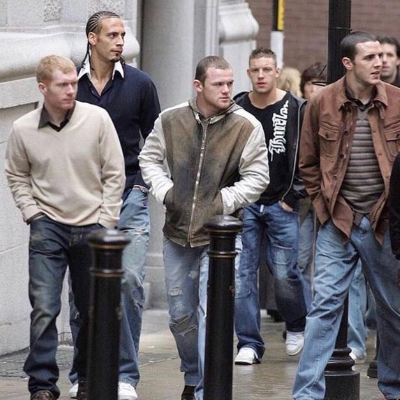the 1980s: the rise of hooligan casual and terrace culture
the 1980s saw hooliganism and ‘casual’ soccer culture dominate fashion, especially in the UK. fans embraced premium sportswear and designer brands (Adidas, Fila, Sergio Tacchini, etc.) with Italian-German and other European inspirations, incorporating them into their everyday wardrobes, with tracksuits, polo shirts, and sneakers (most notably the Adidas Gazelle and Samba). Diego Maradona became an iconic figure in both soccer and fashion during this time, and his style had a global impact.
1990s: The era of streetwear and superstars
the 1990s saw streetwear and retro dominate soccer fashion. david Beckham emerged as a fashion icon both on and off the pitch, popularizing the ‘football shirt + denim’ combination, including oversized tracksuits, replica shirts, and jeans. Hip-hop culture also influenced British soccer fashion during this time, with casual items like caps and chunky trainers becoming popular. fans also began to wear their team’s jerseys off the field as everyday wear.

2000s: Celebrity, hip-hop, and retro converge
in the early 2000s, hip-hop and celebrity culture drove soccer fashion. cristiano Ronaldo, Beckham, and others collaborated with luxury brands like Dolce & Gabbana and Calvin Klein, and it became commonplace to see soccer players in fashion magazines and ad campaigns. retro and modern trends such as low-rise jeans, sneakers, and retro jerseys fused together, and fans began to mix and match vintage kits with modern items.
2010s-2020s: Blurring the lines between high-end and high street
since the 2010s, soccer fashion has become more diverse, with collaborations between sportswear and luxury brands, limited edition collections, and retro revivals. sports brands such as Nike and Adidas and luxury brands such as Dior, Louis Vuitton, and Balmain have collaborated to blur the lines between soccer jerseys and streetwear, players have become ambassadors for fashion weeks and high-end brands, and social media such as Instagram has helped to spread individual styles across the globe, making soccer fashion a global trend that no longer distinguishes between on and off the field.
conclusion: soccer, fashion, and culture evolve without boundaries
from hooligan casual in the 1980s, streetwear in the ’90s, celebrity and retro in the 2000s, to the high-end-street fusion of the 2010s and beyond, soccer fashion has changed with the times and continues to push the boundaries of culture and style. the influence of superstars like Beckham and Ronaldo remains strong, and today soccer is more than a sport – it’s a cultural phenomenon that drives global fashion and lifestyle.






📝 리뷰 작성하기